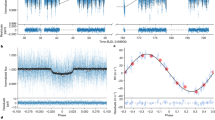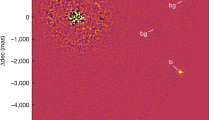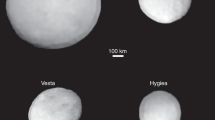Abstract
As part of a systematic programme for the prediction of occultations of stars by planets, attention was called in 1967 to the rare possibility of an occultation (on April 7, 1968) by Neptune (magnitude 7.7, apparent diameter 2″.4) of the star B.D. −17° 4388 (magnitude 7.8). Photographic observations of the relative positions of Neptune and the star at the Royal Greenwich Observatory on March 14, 1968, confirmed this possibility and enabled reliable predictions to be given for this unique opportunity for determining the diameter of the planet. The two existing principal determinations are those of Barnard1, in 1899–1900 (52,900 km = 2″.43 at the mean distance of 30.06 astronomical units), and of Camichel2 in 1953, using a double image micrometer (45,000 km = 2″.07).
This is a preview of subscription content, access via your institution
Access options
Subscribe to this journal
Receive 51 print issues and online access
$199.00 per year
only $3.90 per issue
Buy this article
- Purchase on Springer Link
- Instant access to full article PDF
Prices may be subject to local taxes which are calculated during checkout
Similar content being viewed by others
References
Barnard, E. E., Astronomische Nachrichten, Bd. 157, No. 3760 (1902).
Camichel, Annales d'Astrophysique, 16, 41 (1953).
Author information
Authors and Affiliations
Rights and permissions
About this article
Cite this article
TAYLOR, G. New Determination of the Diameter of Neptune. Nature 219, 474–475 (1968). https://doi.org/10.1038/219474b0
Received:
Issue Date:
DOI: https://doi.org/10.1038/219474b0
This article is cited by
-
Chemistry of the outer solar system
Space Science Reviews (1973)
Comments
By submitting a comment you agree to abide by our Terms and Community Guidelines. If you find something abusive or that does not comply with our terms or guidelines please flag it as inappropriate.



